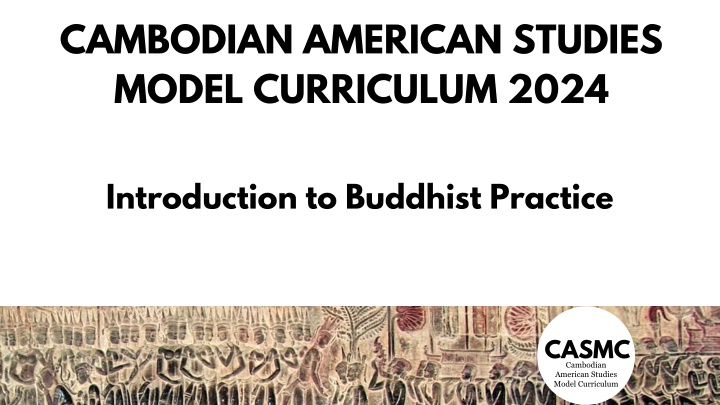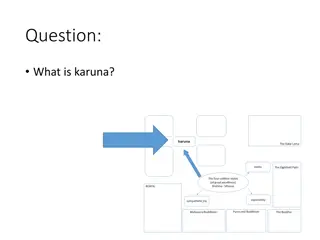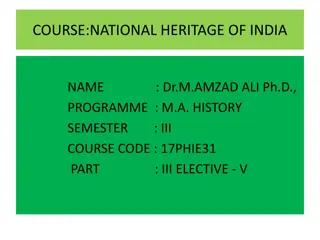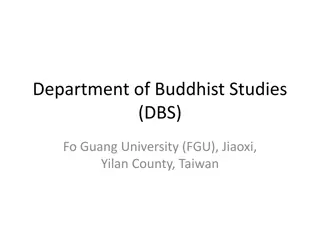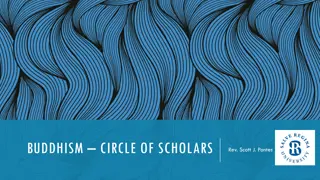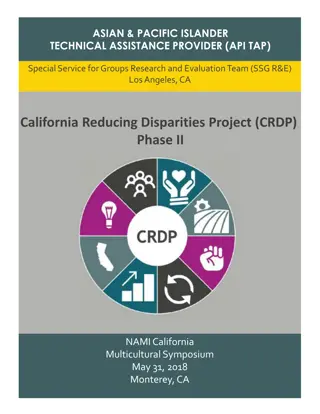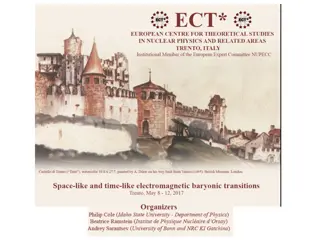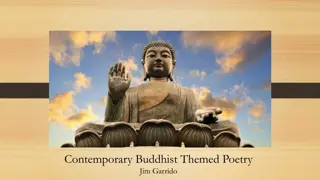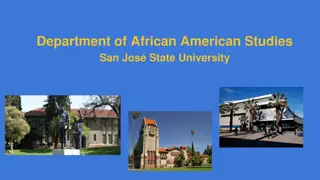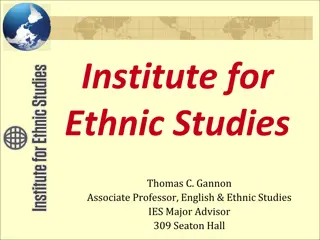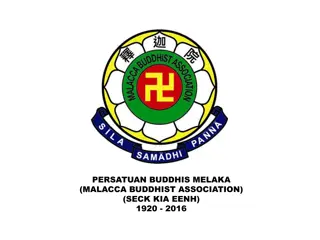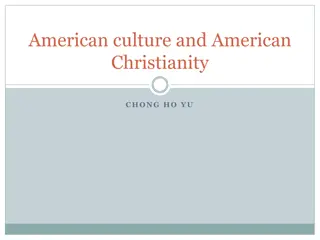Introduction to Buddhist Practice in Cambodian American Studies
This curriculum explores the history of Buddhism, the life of Siddhartha Gautama, central beliefs, and Khmer Buddhism. Students will engage in pre-assessment activities and learn about the Triple Gem, Three Baskets, and more.
Download Presentation

Please find below an Image/Link to download the presentation.
The content on the website is provided AS IS for your information and personal use only. It may not be sold, licensed, or shared on other websites without obtaining consent from the author.If you encounter any issues during the download, it is possible that the publisher has removed the file from their server.
You are allowed to download the files provided on this website for personal or commercial use, subject to the condition that they are used lawfully. All files are the property of their respective owners.
The content on the website is provided AS IS for your information and personal use only. It may not be sold, licensed, or shared on other websites without obtaining consent from the author.
E N D
Presentation Transcript
CAMBODIAN AMERICAN STUDIES MODEL CURRICULUM 2024 Introduction to Buddhist Practice CASMC Cambodian American Studies Model Curriculum
Pre-Assessment Discuss the following questions with a partner to see which ones you have knowledge about: 1. Who is the founder of Buddhism? (Who was the Buddha?) 2. What is the Triple Gem? 3. What are the Three Baskets in Buddhism? 4. Where was Buddhism founded? 5. What is enlightenment? 6. What major holiday(s) do Buddhist communities from all over the world celebrate? 7. What are the five precepts of Buddhism?
Overview of Lesson 1. History of the Founder 2. Central Beliefs of Buddhism 3. Schools of Buddhism 4. Intro to Khmer Buddhism 5. Suggested Reading
Acknowledgment: Remember the Heroes From Left to Right: Preah Maha Vimaladhamm Thon, Preah Uttamamuni Um-Sur, Preah Samdech Chuon Nath, Preah Samdech Huot Tath, and Preah Dhammalikhit Lvi-Em
The Founder of the Religion Founder: Siddhartha Gautama who came to be known as The Buddha . Buddha is a title meaning: Awakened one Born in Lumbini, Nepal to the King of the Shakya Clan. The King s Spiritual Advisor had a vision that Siddhartha would either become a successor of the King or leave his life of royalty to become The Buddha.
The Four Passing Sights Siddhartha became curious about life outside the palace and asked Channa to show him around. During his tour, Siddhartha witnessed four sights that changed his view of life. 1. Siddhartha and his chariot driver Channa saw a elderly man 2. Siddhartha then stumbled upon a Sick man 3. After this encounter, Siddhartha saw a Dead Person 4. Finally he witnessed an Ascetic in a moment of peace
The Choice to Change When he returned to his palace, Siddhartha contemplated the realities that he seen. He became depressed over these revelations so much so that he decided to do something. The palace life of luxury did not provide him the enjoyment that he had before and these images haunted him. After saying goodbye to his wife and son as they slept, he left the palace unannounced with Channa to go to the outskirts of the village to the river. As Siddhartha approached the edge of the village with Channa, he renounced his royal status by giving Channa his horse, removing his royal clothing and cutting off his long hair. He said his final goodbyes to his friend before heading into the woods.
Journey of Self-Discovery toward Truth Siddhartha studied under different masters that trained him in various meditation techniques, taught philosophies to him, and instructed him on how to live with the bare minimum. Siddhartha, still not satisfied with his results, pushed himself further to the point of self-harm including self- starvation that resulted in his body being very weak and frail. Siddhartha realized that if he were to die then, his mission to overcome suffering would fail because he passed away before discovering the truth.
The Middle Way Siddhartha was offered a bowl of milk to nourished himself. He placed the bowl on the river and it floated upstream, indicating that he would find his answers. He later heard a lute player describing how the string of his instrument must neither be too tight or too loose for it to play. Siddhartha was inspired by this understanding which helped him formulate the concept of the Middle Way, the balance between self-indulgence and self-denial.
Moment of Enlightenment Siddhartha meditated under a fig tree that became to be known as the Bodhi Tree at Bodh Gaya. He promised himself that he would remained under that tree until he received his answers. From this long meditation he achieved supreme clarity, insight, and wisdom without fear, anger or worry interfering. He became the Buddha, the One who is Awakened. He shared his teachings at the first sermon in Sarnath to his five first disciples.
The Buddhas Passing At the age of 80, the Buddha Gautama passed away at Kushinagara. Before he enter Nirvana, he gave a final sermon to all of those in attendance in a reclining position. In the sermon he told everyone in attendance not worry, for his teachings would guide them. Ananda, one of the Buddha s closest disciples, was in tears knowing that the Buddha was going to leave. It was Ananda whose excellent memory ensured the perservation of the Buddha s teaching.
Places Important to Buddha 1. Lumbini: Siddhartha s birthplace 2. Bodh Gaya: Place Siddhartha achieved Enlightenment under the Bodhi Tree to become The Buddha. 3. Sarnath: Location of his first-sermon with his first five disciples. 4. Kusinagara: Where The Buddha held his final sermon because passing away
The Four Noble Truths 1. The Noble Truth of Suffering a. Life is Suffering 2. The Noble Truth of the Origin of Suffering a. Suffering is caused by desires 3. The Noble Truth of the Extinction of Suffering a. Suffering can cease when our desires cease 4. The Noble Truth of the Path that leads to the Extinction of Suffering a. To stop suffering, follow the Eightfold Path as instructed by the Buddha
The Three Marks of Existence 1. Impermanence (Anicca) a. All things in life are temporary and are subject to a state of change 2. Non-Self (Anatta) a. The self constantly changes without singular form or identity. 3. Suffering( Dukkha) a. Physical, mental and emotional states are all susceptible to pain
Buddhism and Christianity Compared Similarities Differences Some of the Precepts in Buddhism have parallels to the 10 Commandments that are practical in daily life. Variations of Christianity and Buddhism within their respective faiths, result in diversity in interpretations, traditions, and sects. Both emphasize the importance of love, compassion, peace, and understanding. In Buddhism, there is no belief in God while in Christanity there is a belief in a one true God. In Christianity, Salvation is found in the Father (God), Son ( Jesus) and the Holy Ghost (The Spirit) whereas in Buddhism, Enlightenment is found in the Buddha, Dharma, and the Sangha. In Christianity, believers use prayer to look upward to the divine while in Buddhism meditation allows believers to look inward.
The Eightfold Path Lord Buddha Gotama composed The Eightfold Path that serves as guiding instructions to end suffering. They are divided into 3 categories: Wisdom, Moral, and Concentration. 1. Right understanding (Samma-ditthi) 2. Right thought (Samma-sankappa) 3. Right speech (Samma-Vaca) 4. Right action (Samma-Kammanta) 5. Right livelihood (Samma-Ajiva) 6. Right effort (Samma-Vayama 7. Right mindfulness (Samma-sati) 8. Right concentration (Samma-Samadhi)
Three Schools of Buddhism As Buddhism spread throughout the world, different schools of thought developed along with scriptures, traditions and practices. These are the three (surviving) schools of Buddhism as of this time: Theravada (The Way of the Elders) The oldest surviving school of Buddhism The Sacred text is the Tripitaka Emphasize Arhatship King Asoka was prominent in the spread of Buddhism through this lineage Mahayana (The Great Vehicle) Follow the Sanskrit scriptures Emphasize of Bodhisattva Collection of different traditions Practiced in East Asia Vajrayana (The Diamond Vehicle) Also known as Thunderbolt School Practiced in Tibet, Nepal, Mongolia, and Bhutan Kangyur and Tengyur Text Associated with the Dalai Lama
Three (Surviving) Schools of Buddhism 1.Theravada: Enlightenment is achieved by the monastics Closely connected to the teaching when the Buddha was alive Multiple lifetimes to achieve More Conservative Examples of Theravada Pagodas in Los Angeles: 1. Wat Thai of North Hollywood 2. MonTemple of Los Angeles. 3. Dharma Vijaya Buddhist Temple 2. Mahayana: Much more recent and younger Single lifetime to achieve enlightenment More associated with Gods and deities Example of Mahayana Pagodas in Los Angeles: 1. Hsi Lai Temple of Los Angeles. 2. Lu Mountain Temple. 3. Hihashi Honganji Buddhist Temple
Three (Surviving) Schools of Buddhism (continued) 3. Vajrayana: Sometimes considered a subset of Mahayana Buddhism Example of Vajrayana Pagodas in Los Angeles: 1. Tibetan Buddhist Dharma Monastery. 2. Nechung Dharmapala Center. 3. Sakya Buddhist Center In this tradition, the Buddha is the reflection of our mind or mental states. Use Tantras (chanting to aid in quick enlightenment)
Holidays Celebrated by Buddhists Globally Vesak Day The Buddha s Birthday, Enlightenment and Nirvana. The people would go to a Pagoda to make offerings to the Buddha Falls on the first full-moon of May on the lunar calendar Dharma Day The Day that marks his first sermon at Bodh Gaya Celebration in honor of the historic moment when the teachings were first-shared Falls on the full-moon of July on the lunar calendar Kathina Day Held in October Marks the rainy season retreat when monks and nuns are offered new sets of robes Signifies the relationship between the monastics and the laity
The Tripitaka (The Three Baskets) The Tripitaka are the sacred texts of Buddhism. They are comprise of three volumes: The Suttas, The Vinaya, and the Abhidhamma. 1. The Suttas compose of the sermons and discourses of the Buddha Gautama when he was alive. 2. The Vinaya are the rules of discipline for monastics 3. The Abhidhamma are the philosophical analysis of the teachings of the Buddha.
Khmer Buddhism 95 percent of Cambodia s national population self-identify as Buddhist Before the adoption of Buddhism, the country was lead by Kings who identified with Hinduism. When King Jayavarman VII came to power, he promoted Mahayana Buddhism through civic and social programs that prioritized the needs of the citizens. Cambodia adopted Theravada Buddhism that was introduced by monks from Ceylon (modern day Sri Lanka) Prior to modernization, the Buddhist text was preserved on palm-leaf manuscripts in the Pali Language with Khmer Phonetics
Khmer Buddhism (continued) Samdech Chuon Nath is one of the most prominent Buddhist monks in the history of the Khmer nation whose achievements included writing the song Nokor Reach and Phong Savada Khmer, creating the Khmer Dictionary, and leading the Cambodian Delegation to the 6th Buddhist Council in Yangon, Burma. During the Khmer Rouge Regime Years, Buddhism was targeted by the regime resulting in the systematic persecution of monks, nuns, and lay specialists. Religious institutions that were dedicated to Buddhism, including Wat Ounalom and the Buddhist Institute of Phnom Penh, were attacked. After the removal of the Khmer Rouge Regime, Buddhism was restored as the national religion. Buddhism helped in the healing of survivors in the aftermath of the fall of the regime through mindfulness practices, meditation, and counseling. Today Buddhism continues to exist in Cambodia
Cultural Production Task Create a collage (digital or hand-created) to reflect on the elements of the Buddhist belief system. The collage should be inclusive of content in the slides and video, and include at least 3 of the following categories in their collage: The Four Passing Sights, The Four Noble Truths, The Three Marks of Existence, the Eightfold Path, Schools of Buddhism, Holidays Celebrated by Buddhists All Around the World Alternate Task Construct a written reflection of, and make explicit connections between the categories and its significance in the Cambodian community.
Suggested Reading 1. Chodron, T. (2014). Buddhism - one teacher, many traditions. Wisdom Publications,u.s. 2. Goddard, D. (1994). A Buddhist Bible. Beacon Press. 3. Harris, I. C. (2014). Cambodian buddhism: History and practice. University of Hawaii Press. 4. Hansen, A. R. (2008). How to behave: Buddhism and modernity in Colonial Cambodia, 1860-1930 (1st , Ser. Southeast Asia: Politics, Meaning, and Memory, 43). Silkworm Books. 5. Mortland, C. A. (2017). In Cambodian buddhism in the United States. essay, State University of New York Press. 6. Olcott, H. S. (1915). The Buddhist catechism. Eastern School Press.
Exit Ticket Respond to the questions below in your own words: 1. Describe in your own words, what is Buddhism? 2. What are the Four Noble Truths? 3. Which of the Five Precepts of Buddhism resonate with you? 4. How is Buddhism important to the Khmer people of Cambodia?
